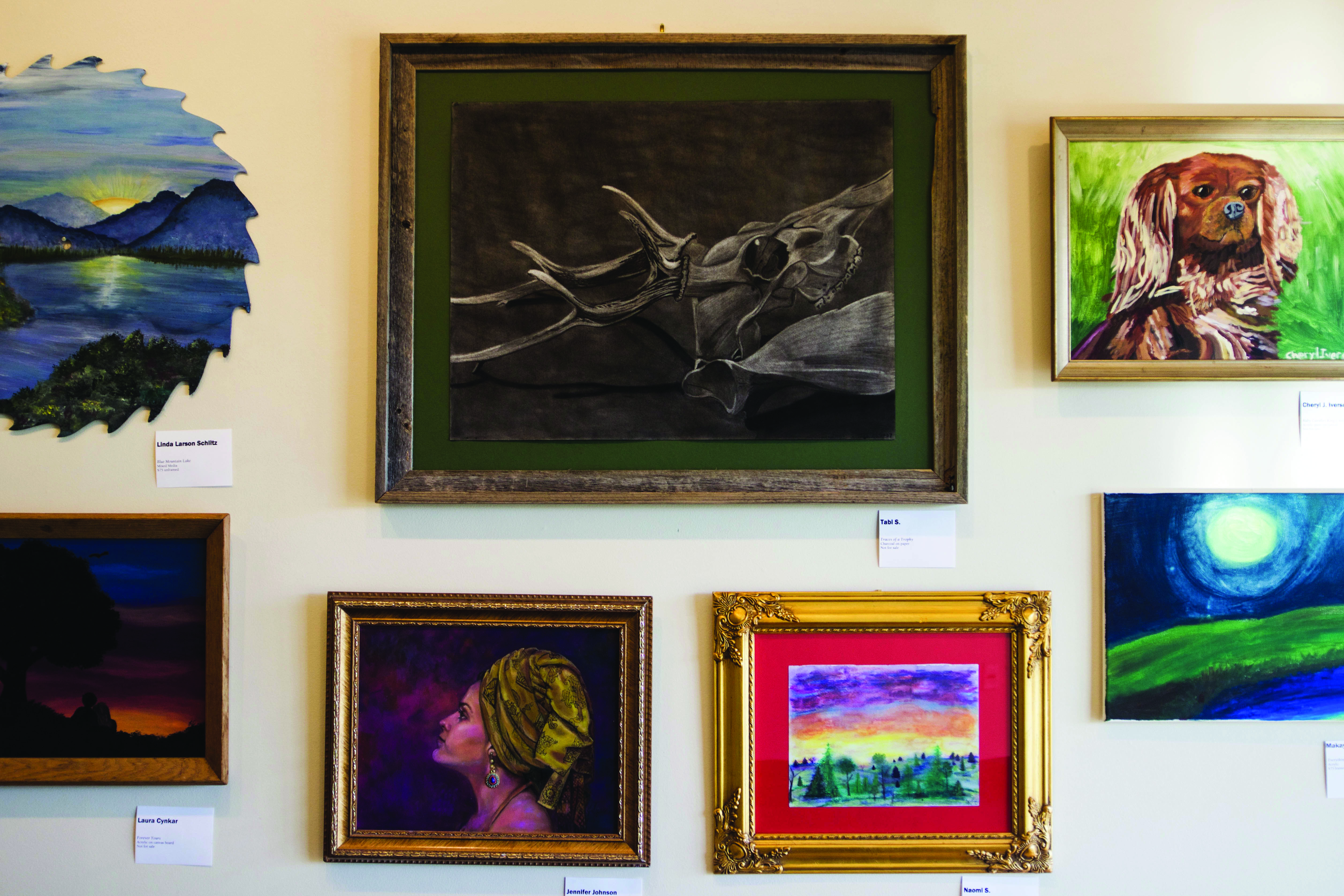Two paintings hang side by side on a peach-colored wall in a small room, which temporarily acts as a small art gallery in Madison.
Even though there are 33 other pieces of art that cover the other walls or rest on a small table, any person entering the space can’t help but notice the multicolored paintings located parallel to the entrance.
From far away, they both look like paintings by Marc Chagall, blurred with unidentifiable shapes of varying sizes, bright colors and unique patterns that use an expressionist style. However, stepping in for a closer look, you notice the paintings were created by two different artists.
Although the two paintings have their differences, it’s what they have in common that is striking. They were created by Therese Wensel and her brother Jimmy Yanny, who both started making art at a young age. The two are also united by their mental illnesses, which they manage through art.
The focal point of the whole gallery hangs above the brother and sister’s paintings: a sign reading “Healing Art Show: An exhibit of works created by individuals with mental illness,” bringing all the art pieces together.
This group of artists uses their love and appreciation of art as a way to help cope with the day-to-day challenges associated with mental health, connect with others in art support groups and express themselves in ways differing from traditional therapy.

Mental illness treatment is not one size fits all
Mental illness comes in varying forms, which means each person has a different system of healing. For the artists in the show, the love of art can help them heal, but for others, support groups, care from loved ones and individual therapy sessions are the answer.
For the past 10 years, NAMI, the National Alliance on Mental Illness, Wisconsin chapter has hosted the Healing Art Show as a way to showcase artwork created by those with mental illnesses.
According to the organization, 43.8 million adults experience mental illness in a given year, which is approximately one in every five adults in the United States alone. Some of the serious mental illnesses include major depression, schizophrenia, bipolar disorder, obsessive compulsive disorder, panic disorder, post-traumatic stress disorder and borderline personality disorder.

While some illnesses overlap, the gallery features a wide range of artists, each using their love of art to help them cope with mental illnesses or express themselves in a creative way. The artist Melissa Meade uses coloring book pages and bright markers, whereas Naomi S. expresses herself through colorful watercolors. David Feingold created a darker digital piece with a yellow-and-red-patterned bald head in the center and what looks like an atomic bomb coming out of the head.
Jamie Gurgul, the public relations and events coordinator for the organization, says the show creates an environment to showcase the artists’ strengths while raising awareness about mental illness. For many artists, creating art for the gallery can be therapeutic.
“All of our artists, they use it as a way to get in touch with their feelings and their emotions,” Gurgul says. “A lot of them have learned ways to use it towards their recovery.”
Gurgul says many artists became interested in art through support and recovery groups, although the creative process helps them no matter which path they took.
The National Alliance on Mental Illness provides free, peer-led support groups for those with mental illnesses. The Dane County branch offers a family support group, a bipolar/depression support group, a women’s depression/anxiety support group and NAMI connection, a group designed for adults with mental illness.
Shruti Rajan, the outreach coordinator for the alliance in Dane County, says the organization focuses on education, advocacy and support for individuals with mental illnesses and their personal support systems like friends and family.
“We want individuals [and family members] to lead [support groups] that have been either affected by [mental illness] or are living with an individual who’ve been affected by mental illness,” Rajan says.
 Rajan says the organization will often get calls from family members who need more information and help figuring out how to assist their loved ones. She says individuals with mental illnesses try to have certain coping mechanisms to handle their illnesses, but sometimes the system can fail, which is called being in crisis.
Rajan says the organization will often get calls from family members who need more information and help figuring out how to assist their loved ones. She says individuals with mental illnesses try to have certain coping mechanisms to handle their illnesses, but sometimes the system can fail, which is called being in crisis.
NAMI acts as a resource for those in crisis because it can direct individuals to the best places for each individual issue, she says.
Outside of support groups, Rajan says it’s important for family and friends to keep an eye out for warning signs and changes in behavior.
“[If] they’re saying that they want to harm themselves,” Rajan says. “Take them serious and not just blow it off because they are actually seeking out for help when they say drastic things like that.”
Using art to stay alive
Wensel has had four suicide attempts — though some were accidental — and one within the past couple of months. She says she has severe depression that stems from the loss of her husband, who took his own life. She blames herself for his death.
Wensel started creating art in high school and she wanted to go to Colorado State University for art, but ended up struggling with her mental health. In her family of eight siblings, five, including Yanny, were diagnosed with multiple mental illnesses.
She says during her latest suicide attempt, she almost died. Now, however, she hopes to never attempt suicide again, wanting to avoid being moved to a halfway house, a place for those with mental illness upon release from a primary care institution.
“That’s what’s keeping me going, my art. It’s why I want to live again,” Wensel says. “I want to do masterpieces.”
Wensel loves to draw and paint women and flowers. She used to draw angry pictures, but now she tries to stay away from creating those kinds of pieces and instead draws like Chagall.
Wensel created a watercolor, “Girl in Pink, Blue, and Gems,” which focuses on a blonde girl in the center of the image with a pink backdrop and pastel flowers encircling the girl from all sides.
When she saw her artwork as part of the slideshow at the gallery opening, her face lit up, and she recalls immediately becoming teary-eyed. She says seeing her artwork makes her feel a lot better, which is partially why she got into creating art again after her husband passed away.
Artists and non-artists alike learn to love expressing through art therapy
As a way to treat mental illness, individual art therapy sessions offered by trained, registered art therapists can be a way to help cope and manage a wide array of mental health issues.
Madison Art Therapy is a private practice specializing in individual-based art therapy sessions with two therapists, Kelly Toltzien and Mary Williams, who met while attending school at Edgewood College and then enrolled in the same art therapy program at Mount Mary University in Milwaukee.

Toltzien says art therapy is something personally fulfilling and a unique alternative that touches on aspects that traditional therapy might not address.
“I think for a lot of people, traditional talk therapy really falls short,” Toltzien says. “There’s just things that art therapy can provide and access within people that words just can’t.”
Creating art is a primal and innate need for people, Williams says. The therapy sessions combine creative ways of expressing feelings through art, including traditional painting, sculpture, poetry writing and dollmaking — and even adding music or movement.
They can use all of the different therapeutic styles in the fields of psychotherapy during sessions, but Williams says art therapy adds a creative process enriched with possibilities.
Toltzien says sometimes people have already discussed a topic or their issue previously, but art therapy provides a new avenue of expression. She says she wished people felt more empowered to interview therapists when trying to choose treatment.
“When I think of art therapy, it really requires people to be an active participant in their treatment, in their recovery, in their growth, in their healing,” Toltzien says. “Not that traditional therapy doesn’t provide [active participation], I feel like [art therapy] provides it in a more tangible way.”
Williams says some people who come to them are not necessarily artists, but anyone can potentially benefit from art therapy, even those struggling with day-to-day stress management or long-lasting mental illnesses. For her, one of the best parts of art therapy is when clients make breakthroughs and connections, altering the course of future therapy sessions.
“The relationships are so rewarding to have that therapeutic relationship with somebody and to witness somebody when they are at their most vulnerable to see them make positive changes in their life,” Williams says.
Loving art before and after diagnosis
Yanny turned to art at a young age, even before being diagnosed with mental illness at age 12. Yanny says he has been diagnosed with autism, anxiety, bipolar disorder and schizophrenia.
Yanny attended the UW-Parkside for five years, earning a degree in fine arts. While in school, he saw a psychologist on campus.
Throughout his life, Yanny says he felt like a girl even though he knew he was a boy. He says he had schizophrenia because he was scared about being a girl trapped in a boy’s body — something which still makes him feel mixed emotions. He tried to be a girl in different ways, but specifically thought creating art was something a girl would do, so it became something he did while growing up.
Yanny says it’s difficult for him to sign his name on his paintings. He was molested by a man on his paper route who told him that his name — with its double M’s and N’s — looked like art. Even though he doesn’t like signing his full name, in his art gallery piece, he did. “Dancing Girls” is a painting that uses pastels over a dried watercolor, capturing two girls who are salsa dancing. As they dance across the canvas in their decorative red dresses, you can barely tell where one dress stops and the other begins.
Yanny says his autism makes it difficult for him to show emotions, but that art allows him to try to understand other experiences and feelings.
“I don’t get angry. I don’t get mad. I don’t get sad. I don’t get happy. I’m emotionless. I’m like an empty shell,” Yanny says. “I just express myself through color, form and light. I just express myself through what I see and feel.”
Maija Inveiss
 When she is not frantically running around Madison writing, Maija is an avid stress baker and lover of anything with too much sugar. She dreams of one day living in New York City and spending all of her time camped out at the Richard Rodgers Theater re-watching Hamilton. Maija will graduate in May with degrees in journalism, strategic communications and French in hopes of working for a large news publication.
When she is not frantically running around Madison writing, Maija is an avid stress baker and lover of anything with too much sugar. She dreams of one day living in New York City and spending all of her time camped out at the Richard Rodgers Theater re-watching Hamilton. Maija will graduate in May with degrees in journalism, strategic communications and French in hopes of working for a large news publication.
